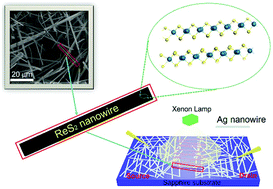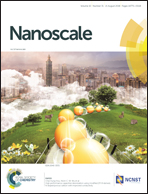Chemical vapor deposition growth of ReS2 nanowires for high-performance nanostructured photodetector†
Abstract
Rhenium disulfide (ReS2) is a recently discovered next-generation transition metal dichalcogenides (TMDs) material that exhibits unique properties, which have resulted in its wide use in the fabrication of electronic and optoelectronic devices. Studies on ReS2 have mainly focused on the synthesis and applications of two-dimensional (2D) materials, while studies on one-dimensional (1D) ReS2 have yet to be reported. Herein, 1D single-crystal ReS2 nanowires have been synthesized successfully for the first time via chemical vapor deposition (CVD) and utilized as the active layer in a nanostructured photodetector. The crystal structure, phonon vibration modes, and chemical states of the single-crystal ReS2 nanowires have been investigated. Furthermore, the nanostructured photodetector using single-crystal ReS2 nanowires as the active layer and Ag nanowire networks as the transparent electrodes exhibited excellent performance, including a higher photoresponsivity (5.08 × 105), the highest external quantum efficiency (1.07 × 106), and the largest specific detectivity (6.1 × 1015) among ReS2 nanostructure-based photodetectors reported to date. Furthermore, the photodetector performance under vacuum conditions was investigated, which provides some information on the work mechanism of the ReS2 photodetector.



 Please wait while we load your content...
Please wait while we load your content...